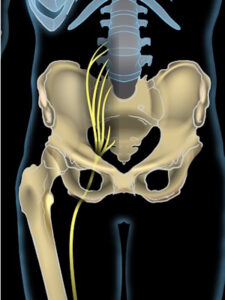 Sciatica can be frustrating, painful, and in some cases downright debilitating. For some people, it means they miss work or struggle with daily activities. When that radiating pain runs from the lower back down into the leg, many patients feel their only options are prescription medications, injections, or even surgery. Fortunately, there’s another path: chiropractic care.
Sciatica can be frustrating, painful, and in some cases downright debilitating. For some people, it means they miss work or struggle with daily activities. When that radiating pain runs from the lower back down into the leg, many patients feel their only options are prescription medications, injections, or even surgery. Fortunately, there’s another path: chiropractic care.
If you’re not familiar with sciatica, we recommend starting with Part 1 of this series: What is Sciatica and Common Causes.
This article explores how chiropractic treatment compares to traditional medical approaches, why it can be such an effective option, and when patients might benefit from choosing chiropractic first.
Traditional Treatment Options for Sciatica
When someone visits a doctor for sciatica, the first line of treatment often includes:
- Medications: NSAIDs or muscle relaxants to reduce pain and inflammation.
- Steroid Injections: Cortisone shots aimed at calming irritated nerves.
- Physical Therapy: Stretching and strengthening to reduce pressure on the sciatic nerve.
- Surgery: Reserved for severe or persistent cases, often involving herniated discs or spinal stenosis.
While these methods can provide relief, they also come with drawbacks. Medications and injections may only mask the pain temporarily. Surgery carries risks, longer recovery times, and isn’t guaranteed to succeed.
How Chiropractic Treatment Addresses Sciatica Differently
Chiropractic care takes a non-invasive, root-cause approach. Instead of simply dulling symptoms, chiropractors look at the musculoskeletal system to identify where the nerve is being irritated or compressed.
- Chiropractic Adjustments: Gentle spinal manipulations restore alignment, which can reduce nerve irritation and improve mobility.
- Targeted Muscle Work: Chiropractors often address muscular entrapments, such as piriformis syndrome, which can mimic or worsen sciatica.
- Lifestyle & Movement Guidance: Patients receive advice on posture, lifting techniques, and exercises to support long-term relief.
By focusing on alignment and natural healing, chiropractic treatment can often reduce pain and restore function without drugs or surgery.
Why Choose an Omaha Chiropractor for Sciatica Relief
At Back2Health Chiropractic in Omaha, patients often come to us after trying medications or injections that provided only temporary relief. As an experienced Omaha chiropractor, Dr. Jeffrey Meyers takes the time to identify the true source of sciatic nerve irritation and develop a personalized, gentle treatment plan to help your body heal naturally.
Because no two cases of sciatica are alike, our Omaha clinic tailors each care plan to the individual—addressing spinal alignment, posture, and muscular tension to promote long-term results.
When Chiropractic May Be the Better First Choice
For many patients, chiropractic offers benefits that traditional care cannot:
- Non-surgical & drug-free relief
- Personalized treatment plans tailored to the exact cause of sciatica
- Focus on long-term function, not just short-term pain management
Research supports this approach. A 2014 study published in the Journal of Manipulative and Physiological Therapeutics found that patients with sciatica who received chiropractic adjustments experienced significant reductions in pain and improvements in mobility compared to control groups.
Common Causes of Sciatica
- Herniated Disc: When disc material presses on the sciatic nerve.
- Spinal Stenosis: Narrowing of the spinal canal, compressing nerve roots.
- Muscular Entrapment: Often from the piriformis muscle irritating the nerve.
Understanding the source of irritation is key — and chiropractors specialize in this kind of evaluation. If you’re looking for an Omaha chiropractor who focuses on sciatica, gentle care, and lasting results, Dr. Meyers and the Back2Health team can help.
The Bottom Line
Sciatica can keep people from work, hobbies, and daily activities, but it doesn’t always require surgery or long-term medication. Chiropractic care provides a safe, effective, and natural alternative for many patients seeking lasting relief.
If you’ve been struggling with sciatic nerve pain and are considering your options, chiropractic may be the right first step toward recovery.
If Sciatic Pain Is Keeping You from Work, Sleep, or the Activities You Love
It’s time to explore a more natural path to healing. At Back2Health Chiropractic in Omaha, Dr. Jeffrey Meyers combines decades of experience with advanced techniques in chiropractic adjustment, acupuncture, and soft tissue therapy to help patients restore balance and function—without relying on medication or surgery.
Schedule your consultation today and find out how chiropractic care can help you move freely again.
Call Back2Health Chiropractic at (402) 898-1540 or schedule an appointment online to get started.


